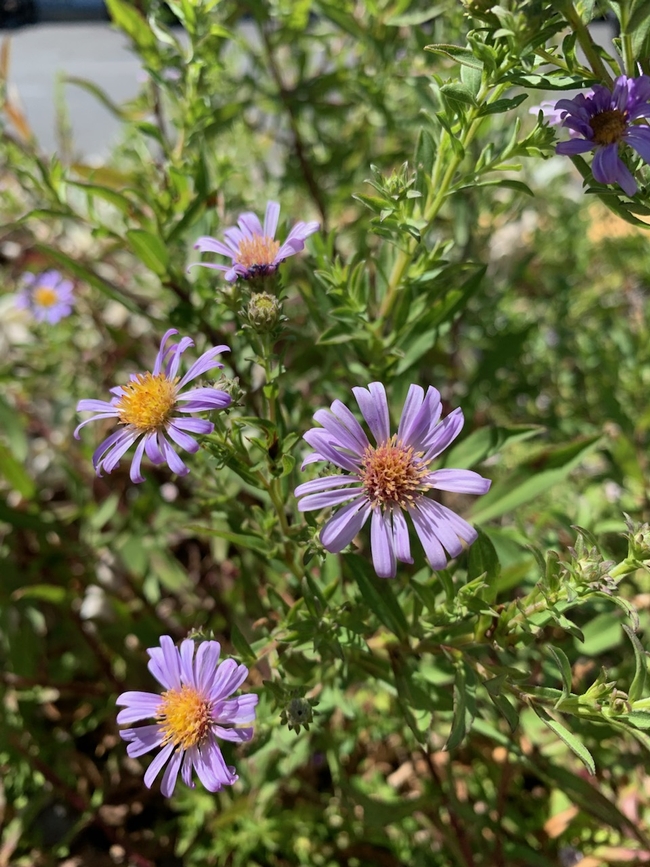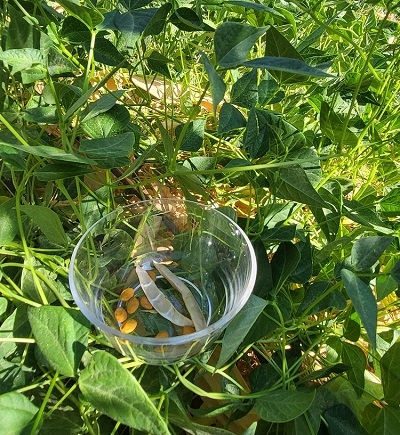- Author: Mary Connolly
“My Orb Spider friend” was in a Sacramento Digs newsletter last year when I first read about Orb spiders. Before reading the article, I had mistakenly assumed the ones I had seen were poisonous. I had recently learned what a black widow spider looked like, and we have a lot around our house, so all webs were considered fair game for extermination. I had walked into some webs that spanned impressive distances: between Rose of Sharon bushes six feet apart, across the back walkway from citrus tree to a raised wall, across Smoke Trees. Fortunately, the spiders did not land on me. Now, I admire the beautiful webs spun in such an intricate and strong pattern that Charlotte and Wilbur would approve of. It is fun to show my grandchildren the webs and the insects that have been caught and bundled. The spiders themselves, now that I know they are friendly, are also fun to observe. Up close, their markings look ferocious; from far away, they blend into the landscape. I have become much more aware to look for them before I go down a path, or water the cherry tomatoes in the garden bed that has a small pomegranate tree next to them. I have noticed that they like to anchor on trees or plants that have slender protuberances, like redwood needles or the pomegranate thorns. That said, one guy, or gal, had the audacity to spin a web right across the door frame of one the sheds in the side yard. Thankfully I saw it, at eye level, or I would have been wearing it. I gently loosened one side of the web and the spider moved with haste on the web to the side of the door and curled up, or whatever spiders do to hide. I wouldn't exactly say that I am having a similar experience to “My Octopus Teacher” (sweet documentary from 2020), but my Orb Spider friends have certainly enriched my outdoor time and added to my overall garden knowledge!
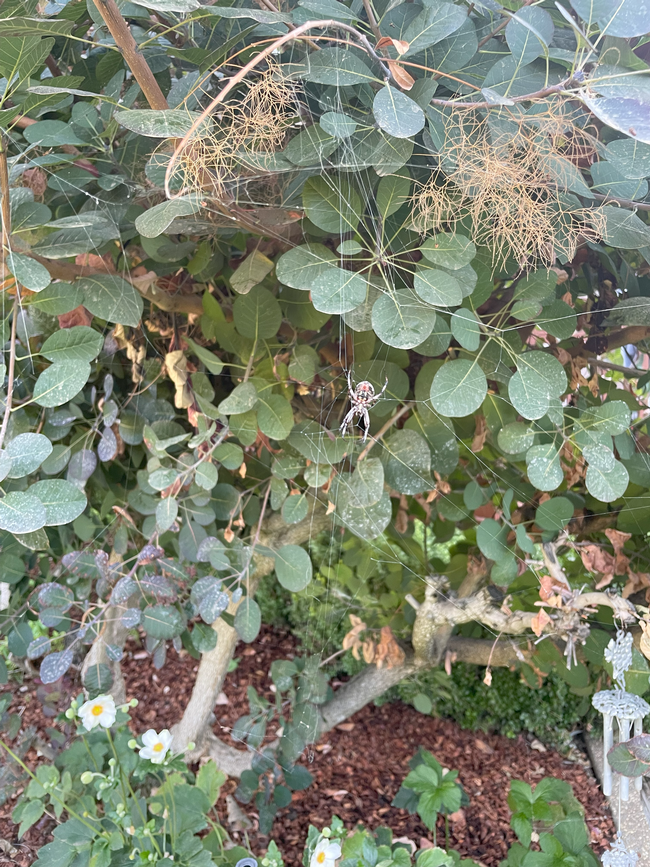
- Author: JD Trebec
Before moving to California about a decade ago, I lived in Tucson, Arizona. Although my new home in Woodland is rightfully known as the Food Front, thanks to the fertile farmland that surrounds it, Tucson also has a highly regarded relationship with food. Tucson is one of two cities in the United States recognized by the United Nations Educational, Scientific, and Cultural Organization (UNESCO) as a City of Gastronomy in recognition of its Sonoran food culture. The city is a center of regional foods that arose in northern Mexico and the Southwestern US. These run the gamut from Sonoran-style hot dogs to wild foods like cactus fruit to local varieties of squash and beans developed by the indigenous people of the border region.
One Tucson crop that I brought with me to try in the fertile soils of the Sacramento Valley is my favorite bean, the tepary. Tepary beans were domesticated by the Tohono O'odham nation of the Sonoran Desert. Tepary beans are a cultivar of Phaseolus acutifolius, a bean species well adapted to life in the desert. The bean plants have narrow teardrop-shaped leaves that turn their surface parallel to the sun's rays to reduce water loss when the sun is too intense.
Traditionally, tepary beans are planted in areas of stormwater runoff from the late summer monsoons in the Southwestern US. They need wet soils to germinate but then are extremely drought tolerant and can survive the vagaries of desert rain and the dry autumn that follows the monsoon. Too much water actually reduces the number of beans produced as more energy is put into growing foliage. The plants grow quickly and beans may be harvested in as little as two months.
The beans are small, about the size of a lentil, with a nutty taste and firm texture. Different varieties are colored brown, black, or white. They are high in protein and research has identified amino sugars specific to the species that protect the bean from heat and prevent the bean's protein from denaturing. I love the beans in my vegetarian chili, but they make a great bean dip or pot of beans as well.
I had always assumed that tepary beans were only known in the Tucson area so I was surprised when I spotted them as an ingredient in snack foods from India. While trying to discover when they were introduced to India, I found that they were once grown in California as well. A USDA pamphlet states that in 1918, California had 17,000 acres planted in tepary bean, but market forces and public preferences caused the tepary bean to fall from favor in the 1920's.
There has been some recent interest in harnessing the tepary bean's heat and drought tolerance as the world becomes warmer which has led to reduced yields in common beans that don't do as well in the heat. A 2015 NPR story describes how Colombian researchers have managed a cross of tepary and common beans that is already benefiting farmers in Central America and Africa. I'm happy to see a little respect for tepary beans, but don't understand why they aren't more widely grown as they are delicious and already adapted for a warmer future.
USDA information: https://plants.usda.gov/DocumentLibrary/plantguide/pdf/cs-pg_phac.pdf
- Author: Heloisa Kinder
The Importance of Native Bees in Ecosystems
When we consider the health and balance of our ecosystems, native bees emerge as unsung heroes playing a crucial role. These incredible insects are primary pollinators for a wide array of wild plants and crops, significantly contributing to biodiversity, food production, and the overall resilience of ecosystems. Unlike honeybees, which are often non-native and managed primarily for commercial purposes, native bees have evolved alongside local flora over millions of years. This co-evolution makes them uniquely adapted to their specific environments, enhancing their effectiveness as pollinators.
The pollination efforts of native bees are vital as they support the reproduction of plants that provide habitat and food for other wildlife. This intricate relationship ensures that ecosystems maintain their biodiversity and can adapt to changing conditions. On an agricultural level, native bees play an essential role by ensuring genetic diversity within plant populations. This diversity is critical for ecological stability, allowing plant populations to adapt to pests, diseases, and climate change.
By making efforts to preserve native bee populations, we extend our protection to these vital pollinators and, by extension, the intricate web of life they support. Their survival is directly linked to the sustainability of our natural ecosystems and agricultural productivity.
In both natural and agricultural ecosystems, bees serve as vital pollinators. As they collect nectar and pollen from flowers, they inadvertently transfer pollen grains from one blossom to another, facilitating plant fertilization. This activity is the backbone for the production of fruits, seeds, and nuts, which constitute a significant portion of the human diet. Beyond human needs, the pollination services rendered by bees are crucial for the reproduction of wild plants, maintaining biodiversity, and the health of ecosystems. Without bees, many plant species would face reduced reproduction, leading to lower crop yields and a decrease in floral diversity. This reduction would have profound implications, not just for nature but also for agriculture and the global food supply.
Impact of Climate Change on Bees
Climate change is having a profound impact on the natural world, and bees are particularly vulnerable to its effects. One of the most significant challenges they face is the alteration of flowering times in plants, which disrupts the synchronized relationship bees have with their environment. Bees rely on specific bloom periods for foraging, emerging from hibernation, or developing based on temperature cues. However, when climate change causes plants to bloom earlier or later than usual, bees can find themselves facing periods of food scarcity. This mismatched timing can weaken bee colonies and reduce their reproduction rates, threatening their long-term survival.
In addition to changes in flowering times, bees are also affected by temperature fluctuations and extreme weather events. The increased frequency and severity of storms, droughts, and heat waves pose significant risks to bee habitats, including their nesting sites and foraging grounds. Ground-nesting bees are especially vulnerable to flooding, while those that nest in wood or stems may find their nesting materials drying and cracking, making them unusable.
Rising temperatures further complicate matters by impacting bee physiology and behavior. Higher temperatures can increase bees' metabolic rates, meaning they need more food, yet also reduce their foraging efficiency and lifespan. This precarious balance can lead to higher mortality rates and lower overall fitness among bee populations, compounding the challenges they face.
The threat climate change poses to bees is not just a concern for these insects but also for the ecosystems and agricultural systems that depend on them as pollinators. Disruptions in bee life cycles, reduced food availability, and habitat alterations can have cascading effects throughout the environment, impacting plant reproduction and food production. Addressing climate change through comprehensive conservation strategies is crucial to protect bee species, maintaining ecological balance, and ensuring the sustainability of ecosystems and agriculture.
Creating a Bee-Friendly Habitat
California, with its Mediterranean climate, presents an ideal environment for creating a bee-friendly habitat. To develop such a garden, it is crucial to select the right plants. Focus on native California plants, as these have evolved alongside local bees and provide the essential nutrients they require. It's also important to consider bloom times by planting a diverse range of flowers that bloom throughout the year, ensuring bees have a continuous food source. Opt for drought-tolerant species, since California's climate can be dry, to sustain your garden during periods of water scarcity. Some excellent native plant options include California poppies,yarrow, sage, lupine, and ceanothus. Providing nesting sites is another essential aspect of fostering a bee-friendly habitat. Leave patches of bare ground to support native bees that nest in the soil and preserve dead wood or create a brush pile for those that nest in hollow stems or dead trees. Building a bee house for cavity-nesting bees is another option, but ensure it is well-ventilated and placed in a sunny location. Additionally, bees need access to water. Offer a shallow dish with pebbles or marbles for bees to land on and change the water regularly to prevent mosquito breeding.
Further tips for attracting bees include avoiding pesticides, as chemicals can harm them. Instead, use organic pest control methods. Also, try to create diverse habitats, as different bee species have varying preferences, which will help attract a broader range. Educating your neighbors and encouraging them to plant their own bee-friendly gardens can also help expand the habitat.
To provide blossoms throughout the seasons, consider the following flowering plants:
In spring, California poppy, ceanothus, and lupine are great choices. California poppies feature vibrant orange flowers, while ceanothus, or California lilac, produce clusters of blue or white flowers, and lupine offers spiky blossoms in colors like purple, blue, and yellow.
During summer, Matilija poppy, coyote mint, and yarrow bloom beautifully. Matilija poppy has large, white, crepe-paper-like flowers with bright yellow centers. Coyote mint offers fragrant purple flowers, and yarrow displays flat-topped clusters of small white or pink flowers.
In the fall, consider planting California fuchsia, goldenrod, and other autumn-blooming plants. California fuchsia produces bright red, tubular flowers, ideal for attracting hummingbirds and bees, while goldenrod presents tall spikes of golden yellow flowers.
Winter, though challenging for many regions, still allows certain hardy species to thrive in California's mild climate, providing bees essential resources. Examples include manzanita, with its small urn-shaped pink or white flowers blooming in late winter, and California redwood sorrel, which produces delicate white or pink flowers in shaded areas under redwood trees. Hummingbird sage often begins blooming in late winter with magenta flowers, while toyon, or Christmas berry, has small white flowers followed by bright red berries. Western redbud's vibrant pink flowers can appear as early as February in mild climates, and mahonia, known as Oregon grape, offers bright yellow flowers in late winter.
Bees Throughout the Seasons
As we mentioned before, California's mild climate and rich biodiversity create an environment where different native bee species can thrive in distinct seasons. Here's a look at how these bees operate throughout the year:
Spring (March-May): Spring is one of the busiest seasons for native bees in California. As the weather warms, many bee species, including bumblebees, mason bees, and sweat bees, become active. They're drawn to the abundance of flowering plants such as California poppies, lupines, and ceanothus. These bees are crucial for pollinating both wild plants and agricultural crops, as they emerge just in time to match the bloom period of many native flowers.
Summer (June - August): As spring fades into summer, other bee species become more prevalent. The hot, dry conditions favor bees that are well-adapted to less water, such as leafcutter bees. During summer, bees can be found pollinating a variety of drought-tolerant plants like yarrow, coyote mint, and sunflowers. These bees play a vital role in the ecosystem by supporting plant reproduction during a time when water availability is low.
Fall (September - November): In the fall, certain native bees are still quite active as they prepare for the upcoming winter. This period sees bees frequenting late-blooming flowers such as California fuchsia and goldenrod. Some bees start to reduce their activity as the days shorten and temperatures drop, while others, like some bumblebee species, remain active until hard frost signals the end of their foraging season.
Winter (December - February): Winter is a challenging time for most bees, but California's climate allows for some activity during the milder periods. Bees like the bumblebee queens that overwinter can occasionally be seen on warmer winter days. Plants such as manzanita and California holly (toyon) provide crucial resources during this time. These plants are important because they offer one of the few reliable food sources in winter, allowing certain bees to continue foraging during mild weather.
In each season, the native bees of California showcase incredible adaptability to their environment. By aligning their life cycles with various flowering periods, they help maintain the health and biodiversity of the state's ecosystems, making them indispensable components of California's natural landscape. Protecting these bees and their habitats is essential to ensuring the persistence of these critical pollination services.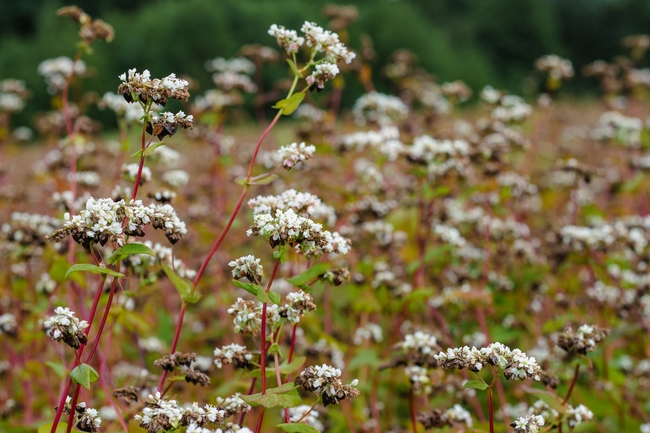
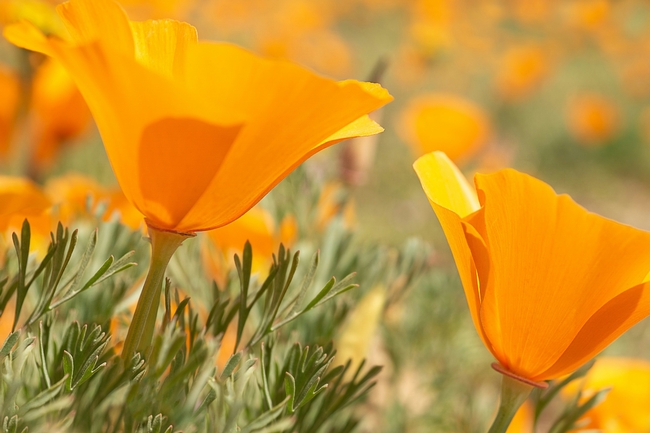
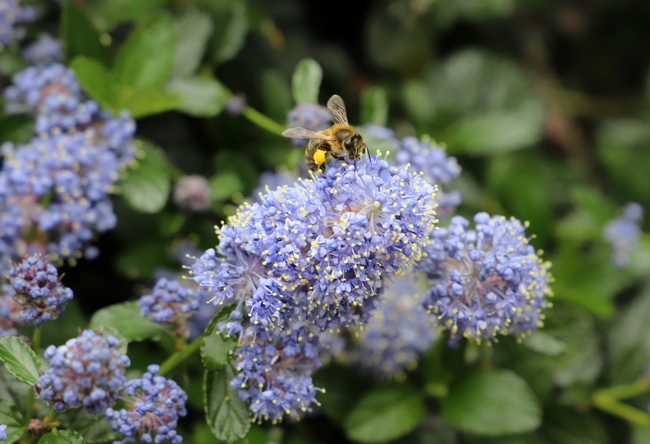
- Author: DJ Andriessen
Now that the Learning Garden in Clarksburg is planted and a great many weeds removed, we needed to concentrate on irrigation. Twice a week, for several hours, we drug a long, heavy hose to the different areas in need of water. This proved to be an arduous, hot, and time-consuming job, but as we all know, water is life, not only to us but also to plants.
Kathy's brother-in-law, Paul reviewed the electrical for the many irrigation stations. He spent several hours testing, repairing, and testing again until he was sure the lines were ready to be hooked up.
Kathy and I met early on a Saturday morning. The beginning temperature was 85 degrees. We laid out the main lines and went to work, punching the holes and adding the drips. We wanted to add one drip per each plant. Using a measure of about an arm's length per drip, we cut the line, attached the couplers, and then the drips.
In the past, I have used a plastic ‘punch', a tool meant to create holes in the main lines. This tool has historically been less useful than frustrating; making dents in the lines instead of holes or creating holes larger than the couplers, thus causing more work to be done by cutting out that line portion. Today, however, Kathy brought a new green tool to the table. It is a plastic device with a metal spike that gets squeezed into the main line, creating a sure and easy hole. What a miraculous invention!
While Kathy prepped the drips as I familiarized myself with the new tool and moved along, punching holes like a pro! Once I punched the hole, I could insert the coupler, and Kathy followed behind, attaching the drips. The process proved to be faster than I had ever experienced. This would have been more enjoyable if the heat hadn't risen to the high 90s before we finished.
When all the work was completed, Kathy went to the pump house and systematically activated all the different stations so we could fine-tune the drips.
Once the lines were installed, activated, and adjusted, we sat back and congratulated ourselves, knowing that, although we were exhausted and overheated, we would no longer need to drag a hose around to irrigate the garden!
On a side note, I went to Lowe's the following day, and purchased the miracle ‘punch tool'.
- Author: Jennifer M Baumbach
As summer begins to wane and many flowers fade, the California Aster enters the spotlight. This resilient wildflower, native to the western United States, brings a burst of color to gardens and landscapes when other blooms are winding down.
The California Aster, scientifically known as Symphyotrichum chilense, is a hardy perennial that thrives in various conditions, from coastal dunes to dry inland areas. Its delicate, star-shaped flowers, ranging in shades from soft lavender to vibrant purple, offer a striking contrast to the golden tones of late summer. These blossoms, often adorned with bright yellow centers, create a beautiful tapestry that attracts bees, butterflies, and other pollinators, making it a vital player in supporting local ecosystems.
What makes the California Aster truly special is its resilience. It can withstand drought, poor soil, and even salty coastal air, making it a favorite among gardeners looking for low-maintenance plants that still deliver high-impact beauty. As the days grow shorter and the first hints of autumn arrive, this aster continues to bloom, offering a final burst of color that extends the garden season well into the fall.
In addition to its ornamental value, the California Aster has a long history of use in traditional medicine by indigenous peoples. They have utilized various parts of the plant to treat ailments. Its adaptability and enduring nature make it a lovely addition to any garden and a symbol of strength and perseverance.
As we transition from summer to fall, the California Aster reminds us that beauty can thrive even in the most challenging conditions. Its late-season blooms are a gentle reminder that every season has its unique charm and that nature's resilience is something to be celebrated.
